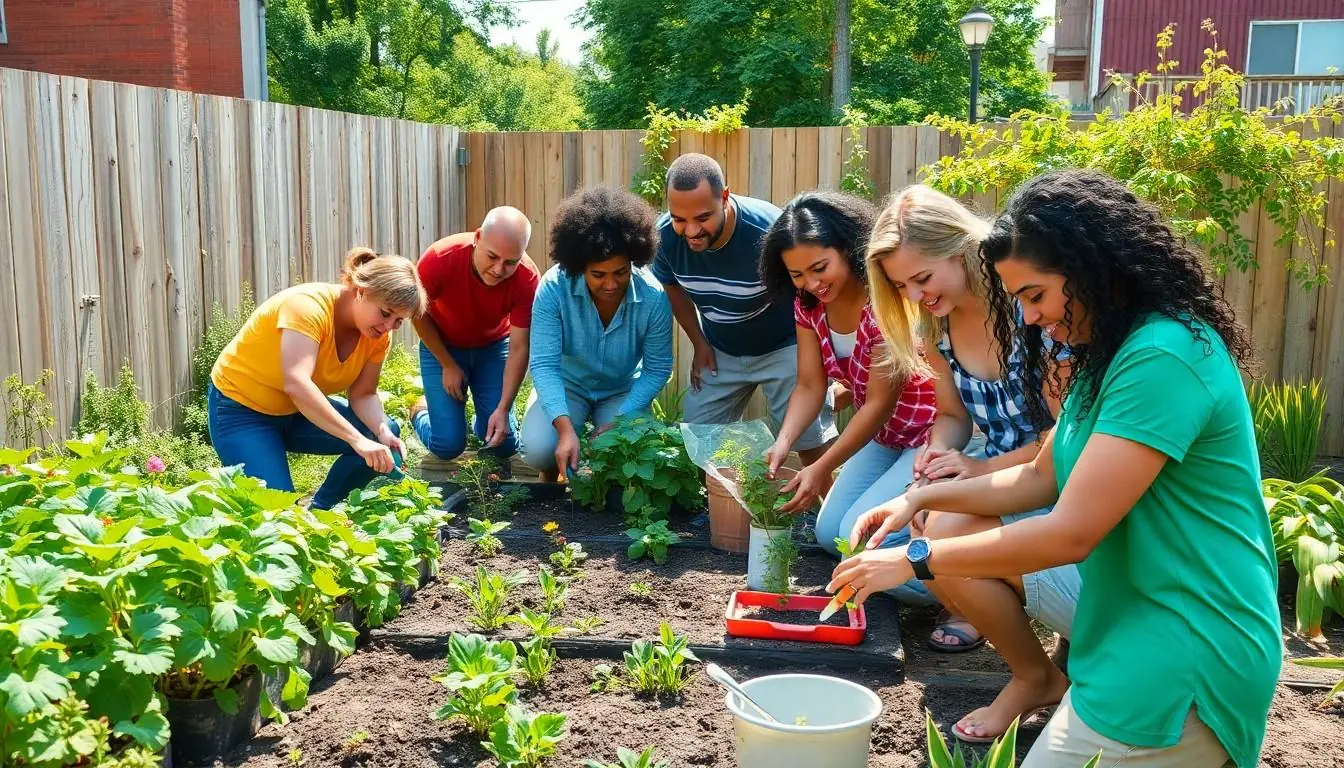In a world where plastic straws are public enemy number one and climate change feels like that awkward relative who just won’t leave, sustainability practices have become the superhero we never knew we needed. They’re not just trendy buzzwords; they’re essential strategies that bridge the gap between human needs and environmental health.
Imagine a future where clean air and fresh water are as common as Wi-Fi—sounds dreamy, right? By embracing sustainability, communities can thrive while keeping Mother Nature smiling. From reducing waste to conserving resources, these practices create a win-win scenario for both people and the planet. So, let’s dive into why sustainability isn’t just a good idea; it’s the only way forward if we want to avoid turning our beautiful Earth into a giant landfill.
Table of Contents
ToggleUnderstanding Sustainability Practices
Sustainability practices encompass strategies aimed at meeting present needs without compromising the ability of future generations to meet their own needs. These practices integrate social, economic, and environmental aspects to create balanced systems.
Definition of Sustainability
Sustainability refers to the capacity to maintain systems over time, considering ecological health, social equity, and economic viability. Its application spans various fields including agriculture, energy, and urban planning. A sustainable approach emphasizes minimizing resource depletion, protecting biodiversity, and promoting equitable access to resources. Practical examples include renewable energy implementations and sustainable agricultural techniques, both of which contribute to a healthier planet.
Importance of Sustainability in Modern Society
Modern society increasingly relies on sustainability practices to combat pressing challenges like climate change and resource scarcity. Prioritizing sustainable solutions leads to reduced waste, enhanced resource efficiency, and improved public health. Businesses adopting sustainable operations often experience increased customer loyalty and brand reputation. Community initiatives focused on sustainability promote social cohesion and empower local populations. These practices foster resilience against environmental hazards while supporting economic growth, thereby creating a balanced ecosystem that benefits all.
Value of Sustainability Practices in Human Systems

Sustainability practices significantly enhance human systems through economic and social improvements. These practices encourage responsible use of resources, fostering longevity and resilience in communities.
Economic Benefits
Sustainability practices offer considerable economic advantages. Companies implementing such practices often experience reduced operational costs through improved efficiency and minimized waste. Increased investment in sustainable technology leads to job creation in green sectors. As consumer demand for eco-friendly products rises, businesses that prioritize sustainability see enhanced market competitiveness. A study by McKinsey shows that companies focusing on sustainability outperform their peers in financial performance. Furthermore, local governments embracing sustainable practices can attract eco-conscious investors, boosting regional economies. Communities benefit from sustainable tourism, contributing to economic stability.
Social Benefits
Sustainability practices positively impact social structures and community well-being. Enhanced public health results from reduced pollution and better resource management. Community initiatives centered on sustainability foster social cohesion and empower local residents through shared goals. Improved access to clean water and nutritious food leads to healthier populations. Education on sustainable practices equips individuals with knowledge and skills necessary for future challenges. Social equity is promoted through fair labor practices and community engagement in sustainability efforts. Stronger social networks emerge from collaborative projects, enhancing community resilience.
Value of Sustainability Practices in Environmental Systems
Sustainability practices play a crucial role in enhancing environmental systems. They address pressing issues like pollution and resource depletion while promoting a healthier planet.
Environmental Protection
Environmental protection serves as a key benefit of sustainability practices. These initiatives reduce harmful emissions and lower waste production. Implementing cleaner technologies leads to significant improvements in air and water quality. Research indicates that sustainable practices can decrease greenhouse gas emissions by up to 50% in certain industries. Communities that adopt these measures often experience fewer health issues linked to pollution. Additionally, regulations promoting sustainability contribute to ecosystem resilience, creating a buffer against climate challenges. Overall, protecting the environment ensures resources remain available for future generations.
Biodiversity Conservation
Biodiversity conservation forms an essential part of sustainability practices. Initiatives aimed at preserving ecosystems contribute to the survival of various species. Practices like sustainable agriculture and forestry promote habitat protection, leading to healthier ecosystems. Recent studies show that areas with sustainable management demonstrate up to 30% more wildlife than those without. Protecting biodiversity provides numerous ecological benefits, including pollination and soil fertility. Supporting local ecosystems fosters resilience against environmental changes while enhancing food security. Prioritizing biodiversity ensures that natural systems continue to thrive and support human well-being.
Integration of Human and Environmental Systems
Integrating human and environmental systems enhances resilience and promotes sustainable growth. Successful practices foster collaboration between social needs and ecological health.
Synergy Between Human and Environmental Sustainability
Mutual benefits arise when human activities align with environmental practices. Economic activities, such as sustainable agriculture, improve food security while preserving ecosystems. Social structures, including community gardens, enhance access to fresh produce and strengthen local bonds. Implementing clean energy solutions not only reduces carbon emissions but also creates job opportunities in green sectors. Prioritizing education on sustainability empowers individuals with relevant skills, leading to informed choices that benefit both communities and the environment.
Case Studies of Successful Integration
Successful examples demonstrate the effectiveness of integrating human and environmental systems. In Sweden, the city of Malmö showcases urban planning that prioritizes green spaces and bike-friendly infrastructure, resulting in decreased car reliance and improved air quality. Singapore offers another example, where vertical gardens promote biodiversity and enhance livability in urban environments. Additionally, initiatives in Costa Rica focus on ecotourism, balancing economic growth with nature conservation, attracting visitors while preserving ecosystems. These case studies highlight the effectiveness of sustainable integration, proving that aligned human and environmental systems yield lasting benefits.
Challenges to Implementing Sustainability Practices
Sustainability practices face several significant challenges that hinder widespread adoption. Understanding these barriers is essential for effective implementation.
Barriers to Adoption
Economic constraints often limit the ability of businesses and communities to invest in sustainable solutions. Financially, upfront costs for sustainable technologies can be substantial, deterring many stakeholders. Additionally, lack of awareness about the benefits of these practices can create reluctance. Stakeholders may not fully grasp the long-term economic advantages or environmental necessity. Cultural resistance also plays a role, as traditions and established practices can be difficult to change. Finally, regulatory hurdles may inhibit innovation and progress, slowing down the transition to sustainable systems.
Solutions for Overcoming Challenges
To overcome these barriers, education and awareness campaigns are crucial. Effective communication about sustainability’s economic and environmental benefits can shift perceptions. Financial incentives, such as grants and tax credits, can encourage investments in sustainable practices. Collaboration between governments, businesses, and communities fosters a supportive environment for innovation. Developing clear regulations can streamline processes, promoting sustainability initiatives. Lastly, creating success stories through pilot programs demonstrates viability, inspiring wider adoption and commitment to sustainability practices.
Embracing sustainability practices is vital for ensuring a harmonious relationship between human and environmental systems. These practices not only address pressing environmental issues but also enhance economic and social well-being. By prioritizing sustainable solutions, communities can thrive while protecting the planet’s resources for future generations.
The integration of sustainability into everyday life fosters resilience and innovation, creating a foundation for a healthier ecosystem. As society navigates the challenges of climate change and resource scarcity, the commitment to sustainability becomes increasingly essential. Ultimately, the path to a sustainable future lies in the collective efforts of individuals, businesses, and governments working together to create lasting positive change.




